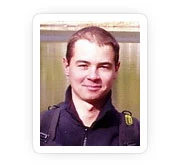Yoga Anatomy: The Adductor Muscles in Downward Facing Dog Pose

Article At A Glance
Curious how to engage the big thigh muscles to protect your knee joints?
Join Dr. Ray long for a yoga anatomy excursion into how to synergize the actions of the large thigh muscles to refine the alignment of the leg bones in Downward Facing Dog Pose. Then learn how to apply this same principle in Urdhva Hastasana (Upward Salute Pose) and other poses.
In our blog post, “Strong Thigh Muscles Benefit People with Knee Osteoarthritis,” we gave a tip for activating the tensor fascia lata in Adho Mukha Svanasana (Downward Facing Dog Pose).
This synergizes the quadriceps for extending the knees, aids in flexing and internally rotating the hips, and helps to align the kneecaps to face forward. You can further refine alignment in this pose by using the adductors longus and brevis and their synergist, the pectineus. Co-activating these muscles and the tensor fascia latae (TFL) balances the external and internal rotation of the femurs while at the same time synergizing hip flexion.

Adductors: First, the Anatomy
The adductors longus and brevis originate from the superior and inferior pubic rami, respectively. The longus inserts onto the middle third of the linea aspera, a ridge of bone on the inside of the femur. The brevis inserts onto the upper third of this ridge. Both muscles act to adduct (draw the thighs together), flex, and externally rotate the hip joint. They also stabilize the pelvis.
The pectineus originates from the pectin of the pubis and inserts onto the pectineal line on the inside of the femur, running from the lesser trochanter to the linea aspera. This muscle adducts, flexes, and externally rotates the hip and stabilizes the pelvis.
Engaging the Adductors: Here’s the Cue
Use Utkatasana (Fierce Pose) to get the hang of isolating the proximal adductor group.
1. Warm up with several rounds of Surya Namaskara (Sun Salutations) A.
2. Then move to Surya Namaskara B. When you take Utkatasana, on your exhalation, gently press the knees together to contract the adductors, longus, brevis, and the pectineus. Note how this action becomes progressively refined with each cycle and with each practice session. You should feel more stable in the pose.

Adductors longus, brevis, and pectineus in Utkatasana
Navasana (Boat Pose) can also be used to gain awareness of the proximal adductors. Squeeze the knees together and feel the muscles contract at the top insides of the thighs. This helps to flex the hips and stabilize the pose. If you’re new to Navasana, try one of the intermediate variations illustrated below and in the Yoga Mat Companion series.
Engaging the adductor group in Utkatasana and Navasana brings awareness and control of these muscles. Once you get a feel for this, contract them directly to refine the alignment of the leg bones in Downward Facing Dog Pose. You can apply this same principle in Urdhva Hastasana (Upward Salute Pose) and other poses. This is an example of the concept of “portability” of the techniques between poses.


Adductors longus, brevis, pectineus in Navasana
Reprinted with permission from the Daily Bandha.
Images are courtesy of the Daily Bandha.
 Author Ray Long MD, FRCSC, is a board-certified orthopedic surgeon and the founder of Bandha Yoga. Ray graduated from The University of Michigan Medical School with post-graduate training at Cornell University, McGill University, The University of Montreal, and Florida Orthopedic Institute. He has studied hatha yoga for over twenty years, training extensively with B.K.S. Iyengar and other leading yoga masters.
Author Ray Long MD, FRCSC, is a board-certified orthopedic surgeon and the founder of Bandha Yoga. Ray graduated from The University of Michigan Medical School with post-graduate training at Cornell University, McGill University, The University of Montreal, and Florida Orthopedic Institute. He has studied hatha yoga for over twenty years, training extensively with B.K.S. Iyengar and other leading yoga masters.
 3d Graphic Designer / Illustrator Chris Macivor has been involved in the field of digital content creation for well over ten years. He is a graduate of Etobicoke School of the Arts, Sheridan College, and Seneca College. Chris considers himself to be equally artistic and technical in nature. As such, his work has spanned many genres, from film and television to video games and underwater imagery.
3d Graphic Designer / Illustrator Chris Macivor has been involved in the field of digital content creation for well over ten years. He is a graduate of Etobicoke School of the Arts, Sheridan College, and Seneca College. Chris considers himself to be equally artistic and technical in nature. As such, his work has spanned many genres, from film and television to video games and underwater imagery.



